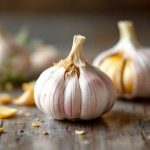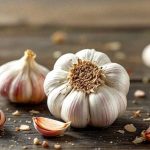Takeaways
- Garlic contains compounds that may help with headache relief
- Its anti-inflammatory and circulatory effects could ease pain
- Some studies suggest garlic may prevent or reduce headaches
- Garlic is generally safe but can interact with certain medications
- More research is needed to confirm garlic’s effects on headaches
- Consult a doctor before using garlic as a headache remedy
Introduction to Garlic and Headaches
Garlic is a common ingredient used in cooking for thousands of years. People appreciate it for its distinct flavor and possible health benefits. Lately, there has been increased interest in whether garlic can help with headaches, a problem that affects many people around the world.
This article examines the connection between garlic and headache reduction. We will explore how garlic might offer relief, what scientific studies indicate, and how to use it safely. This information can be useful whether you experience occasional tension headaches or more frequent migraines.
This discussion will include garlic’s historical usage, its active ingredients, and how it could potentially combat headaches. You will also learn about different kinds of headaches and other natural treatments. By the end, you should understand garlic’s potential in managing headaches.
Garlic: A Natural Remedy
Historical Uses
Garlic has been used as a medicinal plant for a very long time. Ancient cultures valued it for its healing qualities. Egyptians gave garlic to those building pyramids to improve their physical strength.[1] The Greeks and Romans used it to treat various health problems, including headaches.[2]
In traditional Chinese medicine, garlic was used to improve blood flow, which was thought to help with head pain.[3] Ayurvedic practices in India also used garlic for its healing characteristics. Many cultures believed garlic could protect against evil spirits, which they sometimes blamed for headaches.
Modern Applications
Today, garlic remains popular in complementary and alternative medicine. Many people use it to support their heart health and boost their immune system. Some people take garlic supplements to try to lower their blood pressure or cholesterol. These effects might indirectly help with specific types of headaches.
Scientists are now studying the possible benefits of garlic in more detail. Research is focusing on its active ingredients and how they impact the body. While not all historical uses are supported by current scientific evidence, garlic continues to be an area of interest in medicine.
Understanding Headaches
Types of Headaches
Headaches can appear in different forms, each with unique features:
- Tension headaches: Often feel like a tight band around the head
- Migraines: Intense, throbbing pain often on one side of the head
- Cluster headaches: Severe pain around one eye or temple
- Sinus headaches: Pain and pressure in the face and forehead
Identifying the specific type of headache you have can be helpful in choosing the most appropriate treatment. Garlic might be more effective for certain types of headaches than others.
Causes and Triggers
Headaches have many possible causes. Some common triggers include:
- Stress and anxiety
- Dehydration
- Lack of sleep
- Certain foods or drinks
- Environmental factors like bright lights or loud noises
- Hormonal changes
Being aware of your headache triggers can help you prevent them. Here is a comparison of different headache types and their common triggers:
| Headache Type | Common Symptoms | Typical Triggers |
|---|---|---|
| Tension | Dull, constant pain | Stress, poor posture |
| Migraine | Throbbing pain, nausea | Hormones, certain foods |
| Cluster | Severe pain around eye | Alcohol, strong smells |
| Sinus | Facial pain and pressure | Allergies, sinus infections |
Determining your headache type and triggers is the first step toward finding relief. Garlic might be helpful in addressing some of these underlying factors.
Garlic’s Composition
Active Compounds
Garlic contains several active compounds. The most notable is allicin. This substance forms when garlic is crushed or chopped. Allicin is responsible for garlic’s strong odor and many of its potential health benefits.[4]
Other important compounds present in garlic are:
- Diallyl sulfides
- S-allyl cysteine
- Ajoene
These compounds contribute to the potential health effects of garlic. They may help to reduce inflammation and improve blood circulation.[5] Both of these actions could possibly help with headaches.
| Compound | Potential Effects |
|---|---|
| Allicin | Anti-inflammatory, antioxidant |
| Diallyl sulfides | Improve blood flow |
| S-allyl cysteine | Antioxidant, neuroprotective |
| Ajoene | Anticoagulant, anti-inflammatory |
These substances work together to create the overall effects of garlic on the body.
Nutritional Profile
Garlic is low in calories but provides several nutrients. A single clove contains:
- Manganese
- Vitamin B6
- Vitamin C
- Selenium
- Fiber
These nutrients support general health. Some, such as vitamin B6, may be beneficial in relieving headaches.[6] B vitamins are involved in how neurotransmitters function, which can affect pain perception.
Garlic also contains small amounts of other minerals and substances. While they are not directly linked to headache relief, these nutrients contribute to general well-being. A healthy body may be better at coping with pain and stress.
Mechanisms of Action
Blood Flow Regulation
Garlic may help to improve blood circulation.[7] This could possibly help with certain types of headaches. Better blood flow can reduce pressure in blood vessels, which may ease pain.
Some headaches, such as migraines, involve changes in blood flow to the brain.[8] By promoting healthy circulation, garlic might help to prevent or reduce these headaches. However, more research is necessary to confirm this specifically for headaches.
Anti-inflammatory Properties
Inflammation plays a part in many kinds of pain, including some headaches. Garlic contains substances that might help to reduce inflammation in the body. This anti-inflammatory effect could possibly help to ease headache pain.
Studies have shown that allicin and other sulfur compounds in garlic have anti-inflammatory properties.[9] By reducing inflammation, garlic may help to lessen the intensity or frequency of headaches. This effect could be particularly helpful for tension headaches or migraines.
Antioxidant Effects
Oxidative stress can contribute to various health issues, including headaches. Garlic is rich in antioxidants, which help to counteract oxidative stress.[10] By reducing oxidative damage, garlic might help to prevent or reduce headaches.
Antioxidants in garlic, like allicin and S-allyl cysteine, neutralize harmful free radicals. This action may protect nerve cells and blood vessels in the brain. A healthier brain environment could possibly lead to fewer or less severe headaches.
Scientific Evidence
Clinical Studies
Research on garlic’s effects on headaches is limited but shows some promise. One study found that garlic supplements reduced the frequency and severity of migraines.[11] However, this study was small, and more research is necessary to confirm these results.
Another study looked at garlic’s effects on blood pressure, as high blood pressure can sometimes cause headaches. This study found that garlic supplements lowered blood pressure in individuals with hypertension.[12] This effect might indirectly help with certain types of headaches.
Most studies on garlic focus on its overall health benefits. While these do not directly address headaches, they do support garlic’s positive effects on the body. Further research specifically on garlic and headaches is needed before strong conclusions can be reached.
Expert Opinions
Many health professionals acknowledge the potential benefits of garlic. Nutritionists often suggest garlic as a part of a healthy diet. Some headache specialists are open to using natural remedies like garlic, especially in combination with conventional treatments.
However, most experts agree that more research is needed. Current evidence for garlic’s effects on headaches is encouraging but not conclusive. Many doctors recommend trying garlic as a complementary approach, not as a replacement for established treatments.
It is important to remember that individual responses to garlic can vary. What is effective for one person might not be effective for another. This makes it important to approach garlic use for headaches with an open mind and reasonable expectations.
Using Garlic for Headaches
Consumption Methods
Here are several ways to consume garlic for possible headache relief:
- Raw garlic: Eating 1-2 cloves of fresh garlic daily
- Cooked garlic: Adding garlic to meals
- Garlic supplements: Pills or capsules with concentrated garlic extract
- Garlic oil: Applied topically or taken orally
Each method has advantages and disadvantages. Raw garlic provides the most allicin, but it can be difficult for some people to tolerate. Cooked garlic is easier to consume, but may contain fewer active compounds. Supplements are convenient, but vary in quality and effectiveness.
Dosage Considerations
The ideal dose of garlic for headaches is not yet clearly defined. Most studies use doses equal to 1-4 cloves of fresh garlic per day.[13] For supplements, a common dose is 600-1,200 mg of aged garlic extract.[14]
Start with a small amount and gradually increase it if needed. Be aware of how your body reacts. Too much garlic may cause side effects such as bad breath or digestive issues.[15]
Always consult a healthcare professional before using garlic for medicinal purposes. This is especially important if you are taking medications or have existing health conditions. Your doctor can help you determine a safe and effective dose for your situation.
Potential Side Effects and Precautions
Common Side Effects
While garlic is generally considered safe, it can cause side effects in some people:
- Bad breath
- Body odor
- Digestive upset
- Increased bleeding risk
- Allergic reactions (rare)
Most side effects are mild and will go away on their own. They are more likely to occur with larger doses or when consuming raw garlic. Cooking garlic or using odorless supplements can reduce some of these side effects.
Interactions and Contraindications
Garlic may interact with certain medications:
- Blood thinners (e.g., warfarin)
- HIV medications
- Birth control pills
- Some diabetes medications
Individuals with bleeding disorders should use garlic with caution, as it may increase the risk of bleeding.[16] Those scheduled for surgery should stop using garlic at least two weeks before the procedure.[17]
Pregnant and breastfeeding women should consult a doctor before using garlic supplements. While garlic in food is generally safe, large doses might not be appropriate.
Complementary Approaches
Lifestyle Changes
Besides using garlic, several lifestyle changes may help prevent headaches:
- Stay hydrated
- Get regular sleep
- Manage stress through relaxation techniques
- Exercise regularly
- Maintain good posture
- Limit alcohol and caffeine intake
These changes can help to reduce how often headaches occur and how severe they are. They work well alongside other treatments like garlic.
Other Natural Remedies
In addition to garlic, other natural approaches might be helpful for headaches:
- Ginger: May reduce inflammation and nausea
- Peppermint oil: Can provide cooling relief when applied to temples
- Magnesium: Might help prevent migraines
- Butterbur: Shows promise for migraine prevention
- Acupuncture: Can help with various types of headaches
These remedies can be used along with garlic for a well-rounded approach to managing headaches. Always consult a healthcare professional before combining treatments.
Garlic in a Balanced Diet
Culinary Uses
Garlic adds flavor to many dishes, and is a common ingredient in cuisines around the world. Here are some ways to include more garlic in your diet:
- Add minced garlic to sauces and dressings
- Roast whole garlic cloves for a milder flavor
- Use garlic powder as a seasoning
- Add garlic to soups and stews
- Try garlic-infused olive oil
Consuming garlic regularly through diet might contribute to overall health. This could potentially help with headache prevention indirectly.
Garlic Supplements
For those who do not like the taste or smell of garlic, supplements are an option. They are available in various forms:
- Capsules
- Tablets
- Aged garlic extract
- Garlic oil softgels
Supplements offer a concentrated amount of garlic’s active compounds. They are convenient and often odorless. However, the quality and effectiveness can vary among brands. Look for supplements that are standardized for allicin content.
When choosing between fresh garlic and supplements, consider your preferences and goals. Fresh garlic provides additional nutrients and is less processed. Supplements offer convenience and a consistent dose. Either option can be part of a healthy lifestyle.
FAQs
Can garlic really help with headaches?
How much garlic should I eat to relieve a headache?
Are there any risks to using garlic for headaches?
How long does it take for garlic to work on headaches?
Can I use garlic oil for headache relief?
Is garlic better than over-the-counter pain relievers for headaches?
Conclusion
Garlic shows some promise as a natural way to relieve headaches. Its active compounds may help reduce inflammation and improve blood flow. These effects could potentially ease headache pain or help to prevent attacks.
While research is still limited, many people find garlic to be helpful. It is generally safe and offers other potential health benefits beyond headache relief. However, it is not a replacement for established headache treatments.
If you are thinking about using garlic for headaches, speak with your healthcare provider. They can help you decide if it’s right for you and how to use it safely. Keep in mind that garlic is just one element in managing headaches. A comprehensive approach that includes lifestyle changes and appropriate medical care is often the most effective.
Natural remedies such as garlic remind us of the potential of food as medicine. While not a cure-all, garlic demonstrates how common ingredients can support our health. As research continues, we may discover more about garlic’s ability to help with headaches and other health issues.
While the exact effects are hard to verify now, historical texts and the use of garlic as a food source by ancient Egyptians supports the claim. It was certainly used as a dietary component, not necessarily for a performance or strength enhancement as we might understand it today.
Source: “Health benefits of spices in individuals with chemotherapeutic drug-induced cardiotoxicity” https://pubmed.ncbi.nlm.nih.gov/35245798/
Ancient texts and medical writings from the Greek and Roman eras describe the use of garlic as a remedy for headaches and other ailments. However, these uses were based on traditional medicine and lacked modern scientific evidence.
Source: “Health benefits of spices in individuals with chemotherapeutic drug-induced cardiotoxicity” https://pubmed.ncbi.nlm.nih.gov/35245798/
Traditional Chinese Medicine (TCM) often focuses on blood flow and circulation. Garlic has been used in TCM for these purposes, which is consistent with its perceived benefits for headaches in these practices.
Allicin is a sulfur-containing compound that is produced when garlic is crushed or chopped. It is a key component that gives garlic its strong odor and is thought to be responsible for many of its biological activities.
Source: “Garlic bioactive substances and their therapeutic applications for improving human health: a comprehensive review” https://www.ncbi.nlm.nih.gov/pmc/articles/PMC11194342/
Studies suggest that some compounds in garlic, such as allicin and other sulfur-containing compounds, exhibit both anti-inflammatory and vasodilating (blood vessel-relaxing) properties. However, the effects are still under investigation.
Source: “Garlic bioactive substances and their therapeutic applications for improving human health: a comprehensive review” https://www.ncbi.nlm.nih.gov/pmc/articles/PMC11194342/
Vitamin B6 is involved in the synthesis of neurotransmitters that can influence pain and inflammation. Some studies have suggested a potential role for B6 supplementation in headache management, although more research is required.
Some research indicates that compounds in garlic, such as allicin, may relax blood vessels and promote vasodilation, potentially improving blood flow and circulation. However more studies are needed for conclusive evidence for this effect.
Source: “Garlic bioactive substances and their therapeutic applications for improving human health: a comprehensive review” https://www.ncbi.nlm.nih.gov/pmc/articles/PMC11194342/
Migraines are characterized by complex neurological changes, including alterations in cerebral blood flow, which is why some treatments target vascular changes. While the exact pathophysiology is complex and not fully understood, changes in cerebral blood flow are involved in migraines.
Source: “Care Gaps and Recommendations in Vestibular Migraine: An Expert Panel Summit” https://www.ncbi.nlm.nih.gov/pmc/articles/PMC8762211/
Multiple studies have demonstrated that allicin and other sulfur compounds found in garlic have anti-inflammatory properties in vitro and in vivo. These compounds can reduce the levels of inflammatory markers in the body.
Source: “Garlic bioactive substances and their therapeutic applications for improving human health: a comprehensive review” https://www.ncbi.nlm.nih.gov/pmc/articles/PMC11194342/
Garlic contains compounds like allicin, S-allyl cysteine, and other organosulfur compounds that act as antioxidants, helping to neutralize free radicals and reduce oxidative stress in the body.
Source: “Garlic bioactive substances and their therapeutic applications for improving human health: a comprehensive review” https://www.ncbi.nlm.nih.gov/pmc/articles/PMC11194342/
A small number of studies have explored the use of garlic supplements for migraines, with some suggesting potential benefits in reducing frequency and intensity. However, this area requires further investigation through larger and more rigorous studies before definitive conclusions can be drawn.
Several studies, including meta-analyses, have shown that garlic supplementation, particularly aged garlic extract, can have a modest but statistically significant effect in reducing blood pressure levels in individuals with hypertension. However, effects can vary from study to study.
Source: “Aged garlic extract reduces blood pressure in hypertensives: a dose-response trial” https://pubmed.ncbi.nlm.nih.gov/23169470/
Many studies that investigate the health effects of garlic often use a daily dose equivalent to 1-4 cloves of fresh garlic, which is typically the amount used in dietary based trials. Note that the concentration of active compounds will vary from clove to clove.
Many studies and product labels indicate that a common dose of aged garlic extract supplements is typically between 600-1200mg. However, supplement quality and allicin content can vary. Also dosage advice for supplementation varies on a person by person basis.
Source: “Aged garlic extract reduces blood pressure in hypertensives: a dose-response trial” https://pubmed.ncbi.nlm.nih.gov/23169470/
Excessive consumption of garlic, especially raw garlic, can cause side effects such as halitosis (bad breath), heartburn, flatulence, nausea, and other digestive problems. These side effects are generally dose-dependent and usually mild.
Garlic has antiplatelet properties, which can increase the risk of bleeding in individuals with bleeding disorders or those taking blood-thinning medications. It is recommended that individuals with these conditions take precaution with garlic intake.
Source: “Health benefits of spices in individuals with chemotherapeutic drug-induced cardiotoxicity” https://pubmed.ncbi.nlm.nih.gov/35245798/
Due to garlic’s antiplatelet effects, it is often recommended to stop consuming garlic or garlic supplements at least two weeks before scheduled surgeries to reduce the risk of excessive bleeding during and after the procedure. The half life of allicin and other organosulfer compounds are relatively short, which makes this a prudent time frame.
Source: “Health benefits of spices in individuals with chemotherapeutic drug-induced cardiotoxicity” https://pubmed.ncbi.nlm.nih.gov/35245798/
The timeframe for experiencing potential benefits from garlic can vary considerably depending on the individual, the type of headache, dosage, and consistency. Some individuals might experience relief relatively quickly, while others may need a longer period to see effects from regular use.



